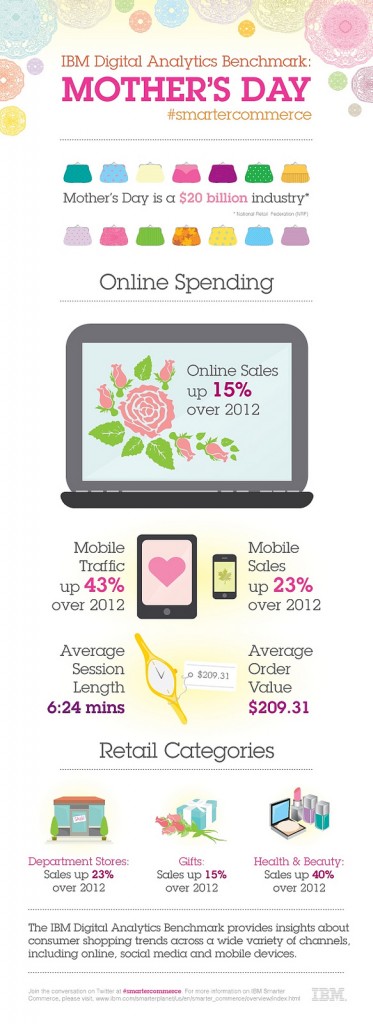Mobile Percentage of Sales Reaches 17 percent, as On-the-Go Consumers Shop for Mom
ARMONK, N.Y. – 16 May 2013: Mother’s Day online shopping grew 15 percent in the week leading up to Mother’s Day, compared to the same time period last year. Spurred by mobile commerce, mobile percentage of sales reached 17 percent, according to IBM’s Digital Analytics Benchmark, a cloud-based analysis of the online retail market.
With the National Retail Federation (NRF) estimating Mother’s Day sales reached $20 billion this year, retailers made it easier for consumers to buy for mom through their smartphones and tablets.
According to IBM’s Benchmark, mobile commerce led the way this Mother’s Day. In the week leading up to Mother’s Day, consumers flocked to their mobile devices, with mobile traffic reaching 25 percent, an increase of 43 percent year over year, with the Apple iPhone and iPad the consumer shopping devices of choice.
As retailers are making it easier for mobile shoppers to browse and buy with a tap of a finger by customizing mobile apps and web sites for on-the-go consumers, the mobile customer experience has become a top priority for retailers looking to streamline the buying process. In the week leading up to Mother’s Day, mobile shoppers browsed and completed purchases in three-and-a-half minutes, while desktop users took twice as long, more than six minutes, to complete their shopping session.
As merchants continue to invest in upgrading support for digital shopping channels, retailers are designing for a MobileFirst market by simplifying the client experience and deepening connections to consumers.
Key findings from the IBM Digital Analytics Benchmark:
· In the week leading up to Mother’s Day, online shopping grew by 15 percent, with average order value reaching $209, representing a four percent increase compared to the same period last year.
· Department store sales grew by more than 20 percent in the week leading up to Mother’s Day compared to the same period last year. Retailers simplified the digital buying experience for customers, with iPad conversions increasing dramatically by more than 315 percent, with iPhone conversions increasing 184 percent.
· In the three weeks leading up to Mother’s Day, online jewelry sales steadily increased, nearly tripling with a 180.6 percent increase in that same period. In the week leading up to Mother’s Day, mobile traffic reached 42 percent, up almost 59 percent over 2012. Mobile sales reached 48 percent, an increase of 38 percent compared to 2012.
· Online sales of gifts including flowers and chocolates more than doubled the week just before Mother’s Day compared to the week before, an increase of 140.8 percent. Mobile percentage of sales was up 109 percent, reaching 28 percent and mobile site traffic was up 95 percent, reaching 34 percent, in the week leading up to Mother’s Day, compared to the same period last year.
· In the week leading up to Mother’s Day, health and beauty sales were up 40 percent compared to the same time last year, with similar mobile commerce gains. Mobile percentage of sales reached 18 percent, a gain of 16.4 percent, with mobile traffic reaching 27 percent, up 33 percent over last year.
By analyzing these trends, Chief Marketing Officers (CMOs), sales, e-commerce and customer loyalty executives can better understand and respond to the needs of customers in terms what and how they prefer to buy.
Today’s news is based on findings from the IBM Digital Analytics Benchmark, the industry’s only cloud-based Web analytics platform that tracks more than a million e-commerce transactions a day, analyzing terabytes of raw data from 500 retailers nationwide. The IBM Digital Analytics Benchmark uses anonymous data to provide the most accurate and immediate snap shot online shopping trends.
For more information about IBM Smarter Commerce, click here.
*Source: IBM

